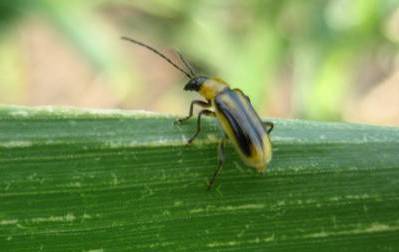Why is it important to scout corn rootworm (CRW) adults?
Scouting corn rootworm (CRW) adults may benefit farmers by helping to make informed decisions for next year’s crop.
Adult Identification
Two CRW species, the western (Diabrotica virgifera virgifera LeConte) and the northern (Diabrotica barberi Smith & Lawrence), account for the majority of CRW damage in Eastern Canada. The larvae are very similar and can be difficult to distinguish from one another. Western corn rootworm (WCRW) adult beetles are identifiable by stripes on the female (Figure 1) or nearly blackish wings on the male (Figure 2).

Figure 1. Western CRW female. Photo courtesy of Frank Peairs, Colorado State University, Bugwood.org.

Figure 2. Western CRW male.
Northern corn rootworm (NCRW) adults are yellowish green to green with females being slightly longer and having larger abdomens (Figure 3).

Figure 3. Northern CRW female.
Scouting
Scouting for CRW beetles should occur regularly through August. All corn fields should be scouted for CRW beetles, especially fields in continuous corn and late-planted corn fields. Rotational crops with volunteer corn should also be scouted for CRW.1
- Count all NCRW and WCRW beetles on two plants in 25 widely separated locations in each field for a total of 50 plants. The distance between each plant sampled must be great enough to prevent disturbing beetles on other plants that will be examined. Avoid the border rows. All beetles found on each plant should be counted, including any located on the ear tip, tassel, leaf surface, and behind the leaf axils.2
- In general, if adult populations exceed 0.75 beetles per plant then there is a potential for significant yield loss the following season. Plan to use control measures the following season.
While scouting, plants should also be evaluated for silk clipping. CRW emerging prior to silk emergence may feed on leaf tissue but silks are preferred once they emerge. Consider the timing of silking compared to neighbouring fields. Fields that silk early or late compared to their neighbors may experience higher densities and injury as adult CRW move into the field.
Management
Cultural control
Rotate to crops other than corn.
Plant refuge of non-Bt corn in Bt corn field if not using a seed blend product containing refuge seed.
Control any volunteer corn that acts as a host for rootworm development.3
If growing continuous corn, rotate between a pyramid Bt-RW and non-rootworm Bt corn with additional control measures.
Planting Date Modification
Early-planted corn plants typically produce more vigourous root systems and have higher yield potential. Planting corn early can also help time early silk development and pollination to occur before peak rootworm beetle emergence. This can minimize the risk of silk clipping and pollination interference.
In contrast, late-planted corn leads to later corn silk development and pollination, increasing the risk of significant silk clipping and kernel feeding injury. Late-planted fields can also be more attractive for egg laying by corn rootworm beetles, and therefore can be at increased risk of larval feeding injury during the following season.4
Insecticide Control
Because of the variability in adult emergence and movement from field to field, Ontario Ministry of Agriculture, Food and Rural Affairs does not recommend insecticide for controlling adult beetles. Instead, plan to use the above management measures the following year. In years when a non-rootworm corn is necessary use soil applied insecticide or seed treatment to manage CRW.1